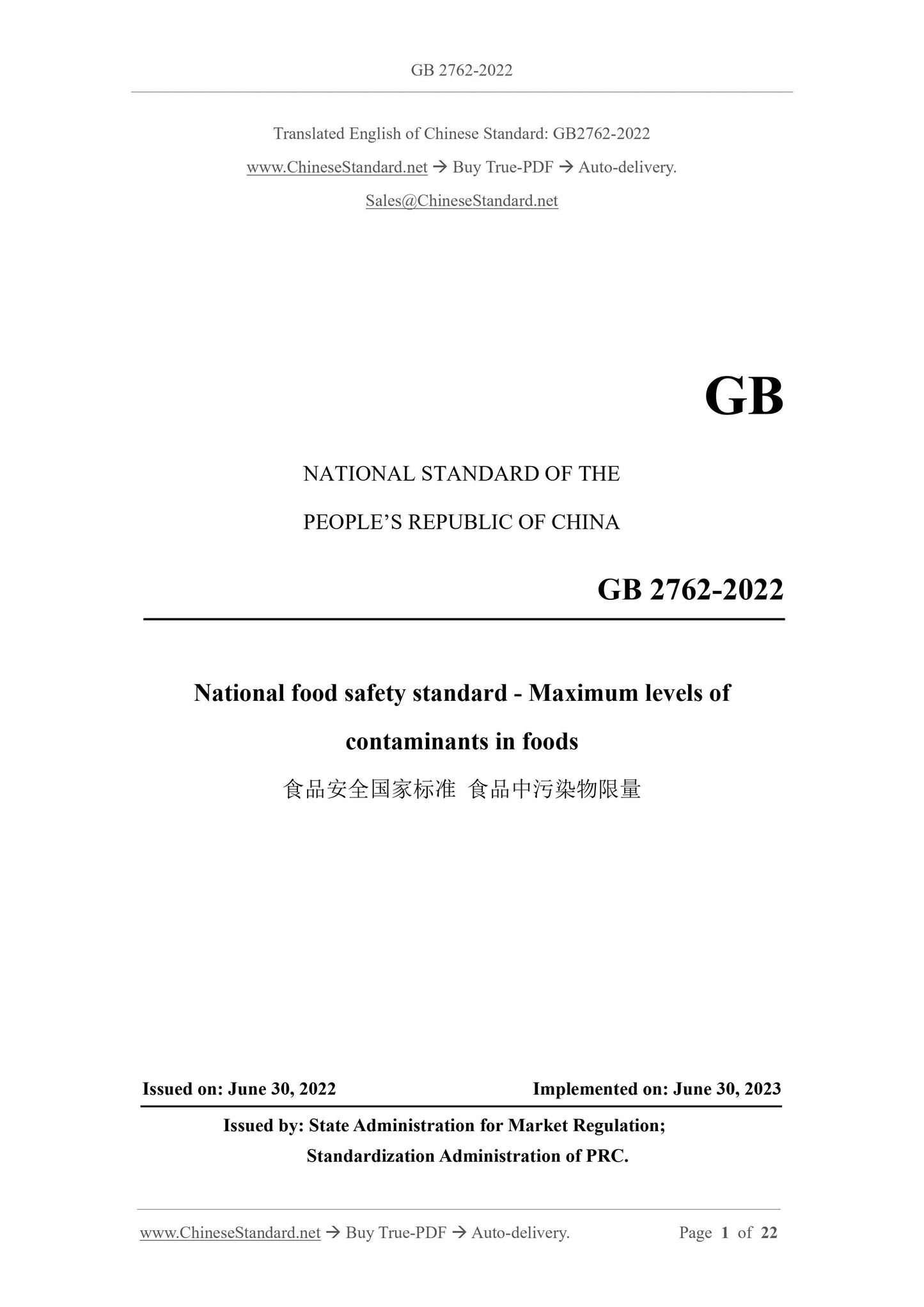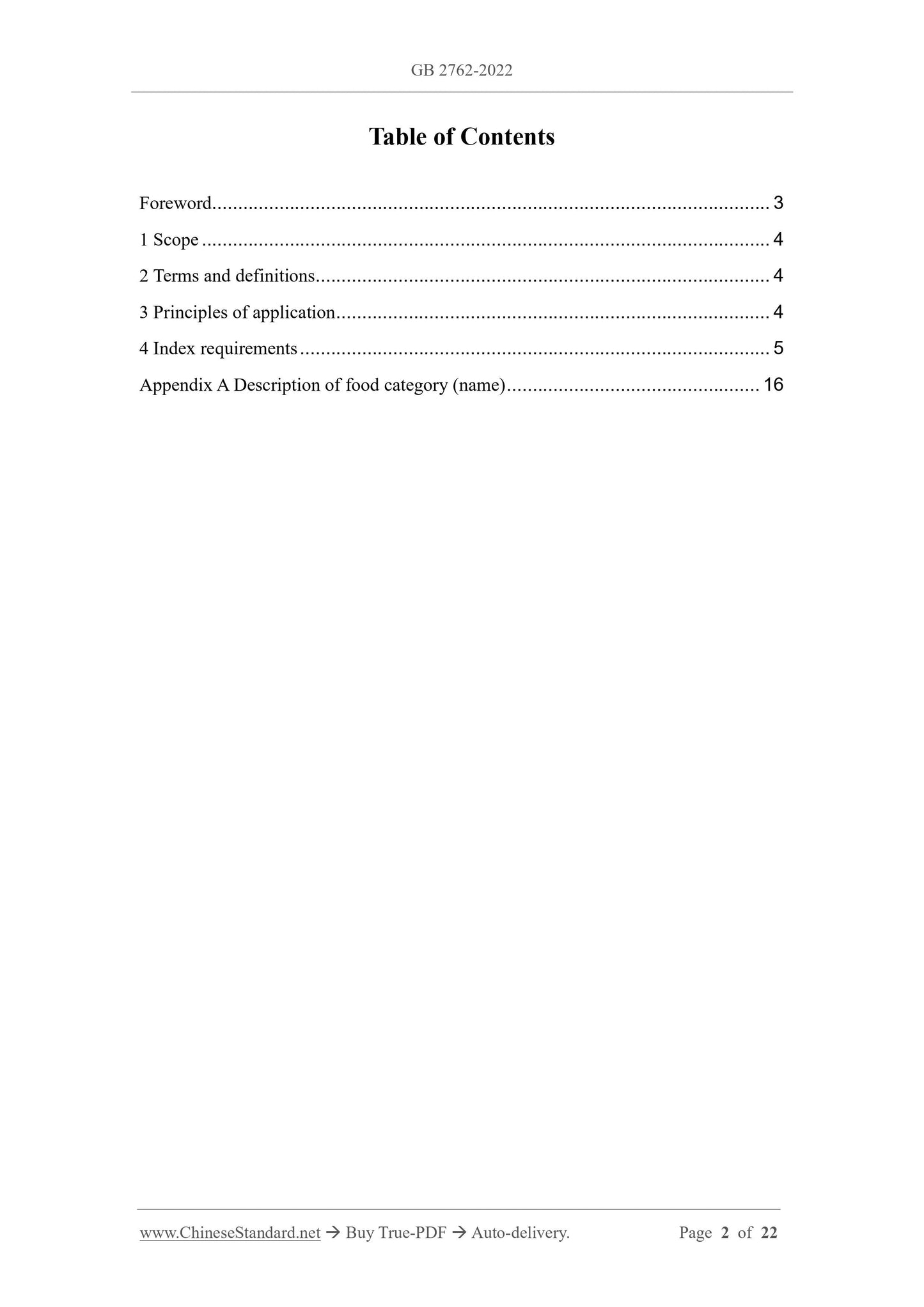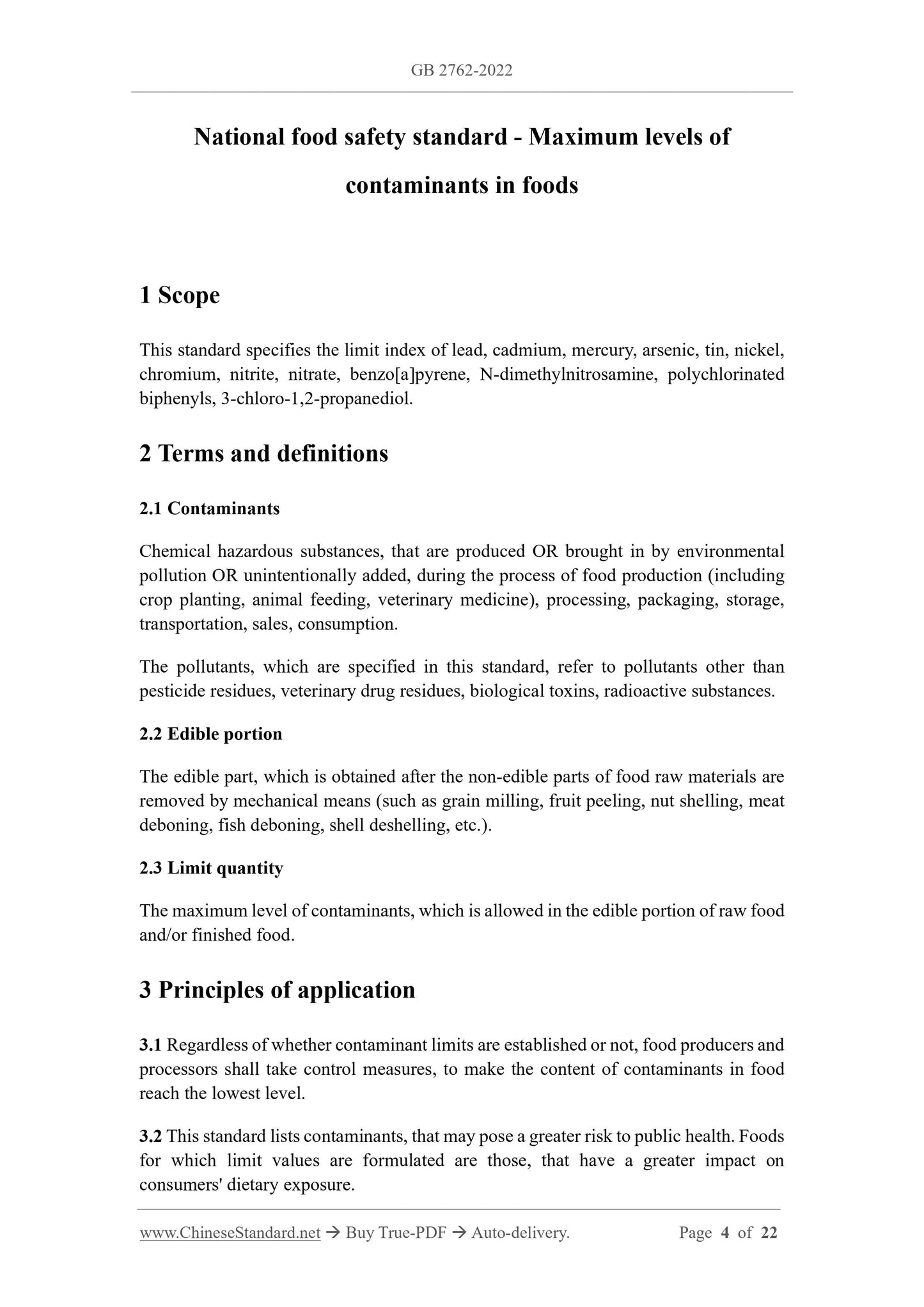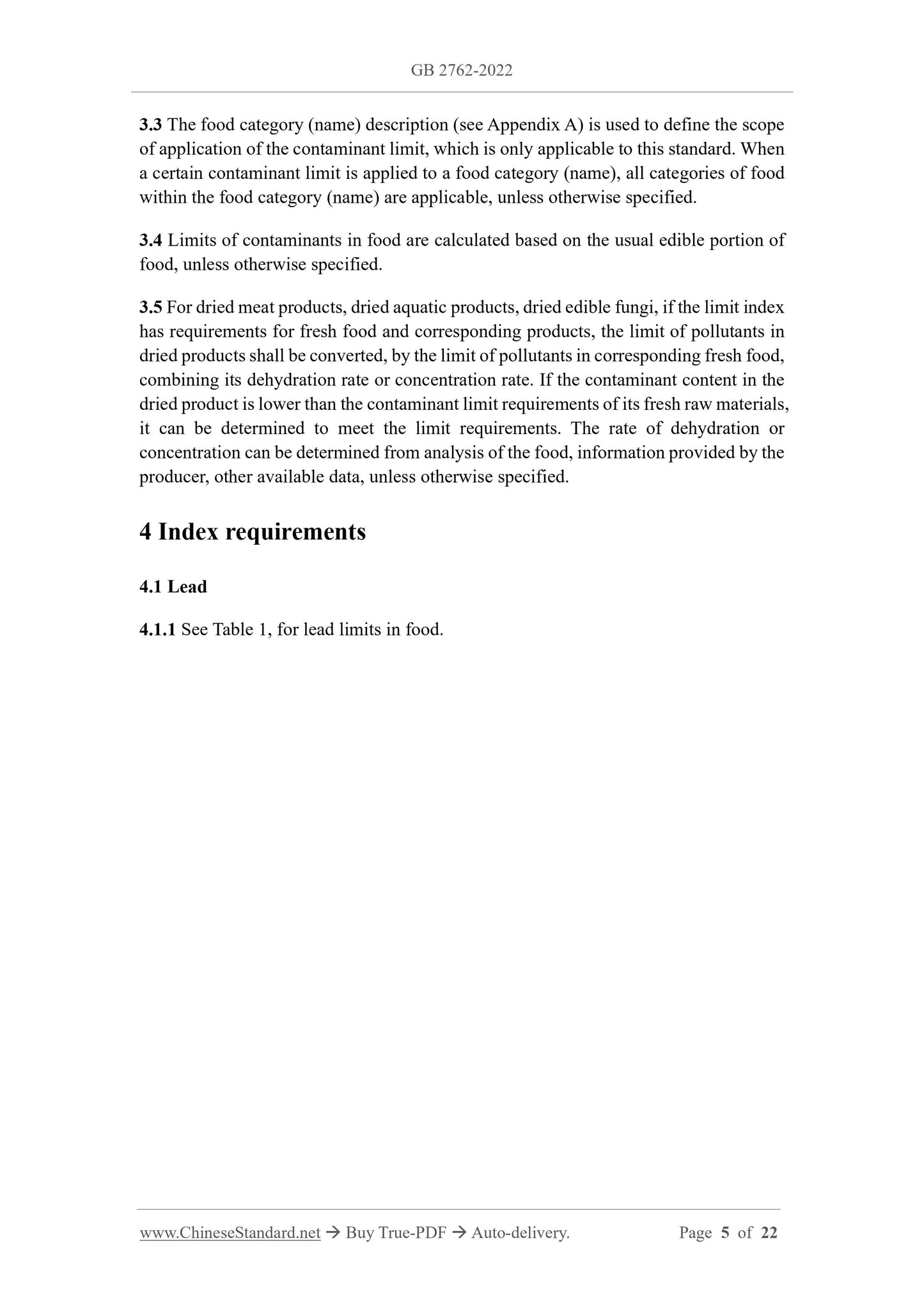1
/
of
4
PayPal, credit cards. Download editable-PDF & invoice in 1 second!
GB 2762-2022 English PDF
GB 2762-2022 English PDF
Regular price
$290.00 USD
Regular price
Sale price
$290.00 USD
Unit price
/
per
Shipping calculated at checkout.
Couldn't load pickup availability
Delivery: 3 seconds. Download true-PDF + Invoice.
Get QUOTATION in 1-minute: Click GB 2762-2022
Historical versions: GB 2762-2022
Preview True-PDF (Reload/Scroll if blank)
GB 2762-2022: National food safety standard - Limits of contaminants in food
GB 2762-2022
NATIONAL STANDARD OF THE
PEOPLE’S REPUBLIC OF CHINA
National food safety standard - Maximum levels of
contaminants in foods
ISSUED ON: JUNE 30, 2022
IMPLEMENTED ON: JUNE 30, 2023
Issued by: State Administration for Market Regulation;
Standardization Administration of PRC.
Table of Contents
Foreword ... 3
1 Scope ... 4
2 Terms and definitions... 4
3 Principles of application ... 4
4 Index requirements ... 5
Appendix A Description of food category (name) ... 16
National food safety standard - Maximum levels of
contaminants in foods
1 Scope
This standard specifies the limit index of lead, cadmium, mercury, arsenic, tin, nickel,
chromium, nitrite, nitrate, benzo[a]pyrene, N-dimethylnitrosamine, polychlorinated
biphenyls, 3-chloro-1,2-propanediol.
2 Terms and definitions
2.1 Contaminants
Chemical hazardous substances, that are produced OR brought in by environmental
pollution OR unintentionally added, during the process of food production (including
crop planting, animal feeding, veterinary medicine), processing, packaging, storage,
transportation, sales, consumption.
The pollutants, which are specified in this standard, refer to pollutants other than
pesticide residues, veterinary drug residues, biological toxins, radioactive substances.
2.2 Edible portion
The edible part, which is obtained after the non-edible parts of food raw materials are
removed by mechanical means (such as grain milling, fruit peeling, nut shelling, meat
deboning, fish deboning, shell deshelling, etc.).
2.3 Limit quantity
The maximum level of contaminants, which is allowed in the edible portion of raw food
and/or finished food.
3 Principles of application
3.1 Regardless of whether contaminant limits are established or not, food producers and
processors shall take control measures, to make the content of contaminants in food
reach the lowest level.
3.2 This standard lists contaminants, that may pose a greater risk to public health. Foods
for which limit values are formulated are those, that have a greater impact on
consumers' dietary exposure.
3.3 The food category (name) description (see Appendix A) is used to define the scope
of application of the contaminant limit, which is only applicable to this standard. When
a certain contaminant limit is applied to a food category (name), all categories of food
within the food category (name) are applicable, unless otherwise specified.
3.4 Limits of contaminants in food are calculated based on the usual edible portion of
food, unless otherwise specified.
3.5 For dried meat products, dried aquatic products, dried edible fungi, if the limit index
has requirements for fresh food and corresponding products, the limit of pollutants in
dried products shall be converted, by the limit of pollutants in corresponding fresh food,
combining its dehydration rate or concentration rate. If the contaminant content in the
dried product is lower than the contaminant limit requirements of its fresh raw materials,
it can be determined to meet the limit requirements. The rate of dehydration or
concentration can be determined from analysis of the food, information provided by the
producer, other available data, unless otherwise specified.
4 Index requirements
4.1 Lead
4.1.1 See Table 1, for lead limits in food.
Get QUOTATION in 1-minute: Click GB 2762-2022
Historical versions: GB 2762-2022
Preview True-PDF (Reload/Scroll if blank)
GB 2762-2022: National food safety standard - Limits of contaminants in food
GB 2762-2022
NATIONAL STANDARD OF THE
PEOPLE’S REPUBLIC OF CHINA
National food safety standard - Maximum levels of
contaminants in foods
ISSUED ON: JUNE 30, 2022
IMPLEMENTED ON: JUNE 30, 2023
Issued by: State Administration for Market Regulation;
Standardization Administration of PRC.
Table of Contents
Foreword ... 3
1 Scope ... 4
2 Terms and definitions... 4
3 Principles of application ... 4
4 Index requirements ... 5
Appendix A Description of food category (name) ... 16
National food safety standard - Maximum levels of
contaminants in foods
1 Scope
This standard specifies the limit index of lead, cadmium, mercury, arsenic, tin, nickel,
chromium, nitrite, nitrate, benzo[a]pyrene, N-dimethylnitrosamine, polychlorinated
biphenyls, 3-chloro-1,2-propanediol.
2 Terms and definitions
2.1 Contaminants
Chemical hazardous substances, that are produced OR brought in by environmental
pollution OR unintentionally added, during the process of food production (including
crop planting, animal feeding, veterinary medicine), processing, packaging, storage,
transportation, sales, consumption.
The pollutants, which are specified in this standard, refer to pollutants other than
pesticide residues, veterinary drug residues, biological toxins, radioactive substances.
2.2 Edible portion
The edible part, which is obtained after the non-edible parts of food raw materials are
removed by mechanical means (such as grain milling, fruit peeling, nut shelling, meat
deboning, fish deboning, shell deshelling, etc.).
2.3 Limit quantity
The maximum level of contaminants, which is allowed in the edible portion of raw food
and/or finished food.
3 Principles of application
3.1 Regardless of whether contaminant limits are established or not, food producers and
processors shall take control measures, to make the content of contaminants in food
reach the lowest level.
3.2 This standard lists contaminants, that may pose a greater risk to public health. Foods
for which limit values are formulated are those, that have a greater impact on
consumers' dietary exposure.
3.3 The food category (name) description (see Appendix A) is used to define the scope
of application of the contaminant limit, which is only applicable to this standard. When
a certain contaminant limit is applied to a food category (name), all categories of food
within the food category (name) are applicable, unless otherwise specified.
3.4 Limits of contaminants in food are calculated based on the usual edible portion of
food, unless otherwise specified.
3.5 For dried meat products, dried aquatic products, dried edible fungi, if the limit index
has requirements for fresh food and corresponding products, the limit of pollutants in
dried products shall be converted, by the limit of pollutants in corresponding fresh food,
combining its dehydration rate or concentration rate. If the contaminant content in the
dried product is lower than the contaminant limit requirements of its fresh raw materials,
it can be determined to meet the limit requirements. The rate of dehydration or
concentration can be determined from analysis of the food, information provided by the
producer, other available data, unless otherwise specified.
4 Index requirements
4.1 Lead
4.1.1 See Table 1, for lead limits in food.
Share








